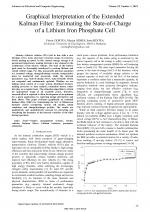| 3/2018 - 5 |
Graphical Interpretation of the Extended Kalman Filter: Estimating the State-of-Charge of a Lithium Iron Phosphate CellCIORTEA, F. |
| Extra paper information in |
| Click to see author's profile in |
| Download PDF |
Author keywords
battery management systems, electric vehicles, Kalman filters, Lithium batteries, parameter estimation
References keywords
kalman(11), battery(10), filter(8), extended(7), state(6), estimation(6), power(5), charge(5), optim(4), control(4)
Blue keywords are present in both the references section and the paper title.
About this article
Date of Publication: 2018-08-31
Volume 18, Issue 3, Year 2018, On page(s): 29 - 36
ISSN: 1582-7445, e-ISSN: 1844-7600
Digital Object Identifier: 10.4316/AECE.2018.03005
Web of Science Accession Number: 000442420900005
SCOPUS ID: 85052087917
Abstract
Electric vehicles (EVs) fall in line with a new ideology of less waste and more conscious usage of resources, slowly picking up speed. In this context, energy storage is of paramount importance, making batteries a key element in the architecture of the electric vehicles. The state of the battery pack must be thoroughly monitored to prolong lifetime and extend vehicle range. For this, measurable physical quantities (i.e. terminal voltage, charge/discharge current, temperature) must be monitored and processed, while the inferred parameters (e.g. state-of-charge (SoC), state-of-health (SoH)) are computed and continuously updated. Whether we are talking about control of a noisy system, ill-defined decision-making processes or data analysis, estimation theory comes into play on a regular basis. The estimation algorithm is critical for appropriate usage of all available power, therefore, research effort is required to allow development of an optimum for a given application, by exploring design alternatives and their effects. This paper evaluates graphically an extended Kalman filter (EKF) for determining the SoC of lithium-ion batteries (LIBs) considering various cell models, initial conditions and charge/discharge profiles. The results are qualitatively and quantitatively assessed by extracting and visualizing the dynamics of the internal variables of the filter during operation. |
| References | | | Cited By |
Web of Science® Times Cited: 1 [View]
View record in Web of Science® [View]
View Related Records® [View]
Updated 2 weeks, 6 days ago
SCOPUS® Times Cited: 5
View record in SCOPUS® [Free preview]
View citations in SCOPUS® [Free preview]
[1] Performance Comparison of Conventional and Intelligent method of Charge Estimation, Shankar, Nathan, Chitra, A., Banerjee, Devatri, Sharma, Vaibhav, Zhutshi, Kalpana, Razia Sultana, W., 2021 Innovations in Power and Advanced Computing Technologies (i-PACT), ISBN 978-1-6654-2691-6, 2021.
Digital Object Identifier: 10.1109/i-PACT52855.2021.9697046 [CrossRef]
[2] An IOT-based Battery Surveillance System For E-Vehicles, Surendar, M, Pradeepa, P, 2021 Fifth International Conference on I-SMAC (IoT in Social, Mobile, Analytics and Cloud) (I-SMAC), ISBN 978-1-6654-2642-8, 2021.
Digital Object Identifier: 10.1109/I-SMAC52330.2021.9640928 [CrossRef]
[3] Comparison and Evaluation of State of Charge Estimation Methods for a Verified Battery Model, Nemounehkhah, Behrooz, Faranda, Roberto, Akkala, Kishore, Hafezi, Hossein, Parthasarathy, Chethan, Laaksonen, Hannu, 2020 International Conference on Smart Energy Systems and Technologies (SEST), ISBN 978-1-7281-4701-7, 2020.
Digital Object Identifier: 10.1109/SEST48500.2020.9203121 [CrossRef]
Disclaimer: All information displayed above was retrieved by using remote connections to respective databases. For the best user experience, we update all data by using background processes, and use caches in order to reduce the load on the servers we retrieve the information from. As we have no control on the availability of the database servers and sometimes the Internet connectivity may be affected, we do not guarantee the information is correct or complete. For the most accurate data, please always consult the database sites directly. Some external links require authentication or an institutional subscription.
Web of Science® is a registered trademark of Clarivate Analytics, Scopus® is a registered trademark of Elsevier B.V., other product names, company names, brand names, trademarks and logos are the property of their respective owners.
Faculty of Electrical Engineering and Computer Science
Stefan cel Mare University of Suceava, Romania
All rights reserved: Advances in Electrical and Computer Engineering is a registered trademark of the Stefan cel Mare University of Suceava. No part of this publication may be reproduced, stored in a retrieval system, photocopied, recorded or archived, without the written permission from the Editor. When authors submit their papers for publication, they agree that the copyright for their article be transferred to the Faculty of Electrical Engineering and Computer Science, Stefan cel Mare University of Suceava, Romania, if and only if the articles are accepted for publication. The copyright covers the exclusive rights to reproduce and distribute the article, including reprints and translations.
Permission for other use: The copyright owner's consent does not extend to copying for general distribution, for promotion, for creating new works, or for resale. Specific written permission must be obtained from the Editor for such copying. Direct linking to files hosted on this website is strictly prohibited.
Disclaimer: Whilst every effort is made by the publishers and editorial board to see that no inaccurate or misleading data, opinions or statements appear in this journal, they wish to make it clear that all information and opinions formulated in the articles, as well as linguistic accuracy, are the sole responsibility of the author.



